Across the road from the administration and maintenance areas is the Parade Field, a large grass-covered area used for retreats, parades and flag ceremonies. I remember going there, both as a camper and a counselor, for camp-wide flag lowering ceremonies. There would be hundreds of campers, all smartly attired in uniform, complete with troop and patrol flags. While the field had been well kept in my time, it was looking pretty ragged in later years. When I was there in 1978, just a few years past the prime days of the camp, there was high grass and bare spots that marked the once spotless field. By 1983 it was even worse, as seen here, with nature doing its best to reclaim the area. Happily, another trip in 1998 found the field in much better condition, with the grass recently cut. In recent years the Parade Field has been looking much better, helping make the first view many people have of Orchard Lake a more enjoyable moment.
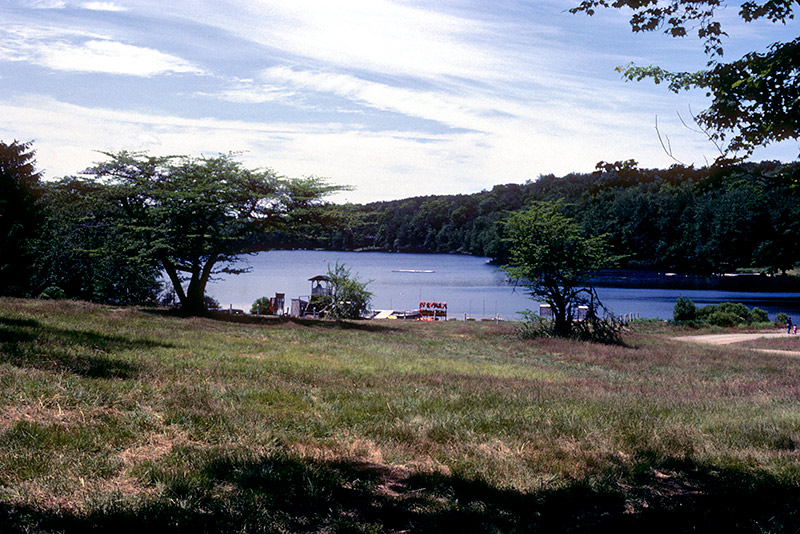
Parade Ground and Orchard Lake (1983)
Next to the flag pole in the middle of the Parade Field is a large boulder and plaque, which reads:
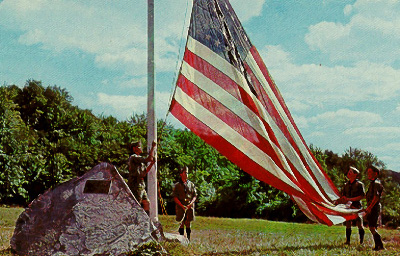
Retreat at the Parade Grounds (1960s)
Mr. Caspary was one of the foremost collectors of United States stamps. His gift was essential in making Onteora a reality.
Just to the left of the parade field, facing the lake, was a large amphitheater used for camp fires and award ceremonies. Scouts entered from the Parade Field, passing underneath a very large statue of an Indian warrior. The statue was about 20 feet tall, and can be seen on Jim Sannerud's web page on Onteora. Consisting primarily of rough wooden benches in a horseshoe shape, the amphitheater also had a stage area with two spots for bonfires on either side. There were some impressive Indian dance performances, with the dancers arriving across the lake by canoe. Award ceremonies were also conducted there, and I received my Eagle medal there in 1969. Today, all that remains is a clearing, covered mainly in ferns as nature reclaims the site. If you look carefully you can spot a few weathered logs with rusty nails, the remnants of the old benches.
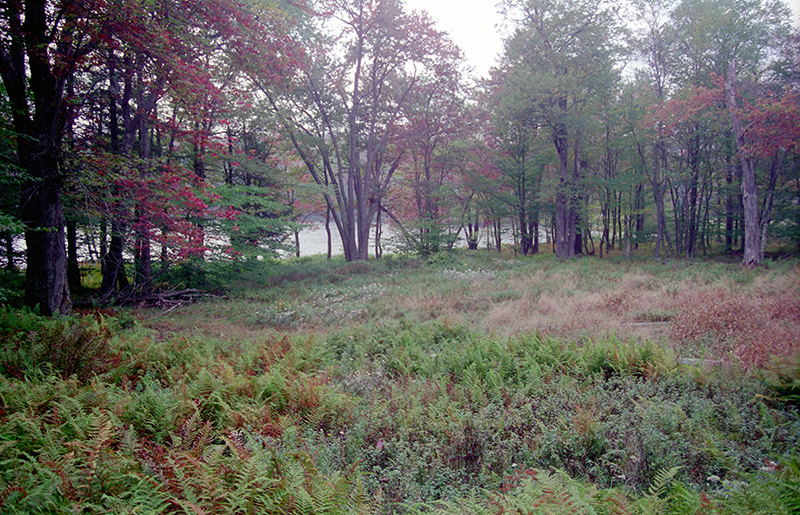
Former Amphitheater site (1998)
As you continue along the road that rings the parade field, you'll pass the former site of the Tuttle House, a now-demolished structure once used for senior staff housing. It was once the home of the camp caretaker, Leland Tuttle, a very colorful character indeed. The house would have been just to the right of the tree in the picture below. Pretty nice view, isn't it? Keen-eyed observers may spot a cloud of dust from a camp truck passing by. As you can tell, the road is dirt at this point, and anyone who has driven their own car through the property can probably remember wondering if their muffler and tires would survive the trip.

Looking towards Orchard Lake (1983)
This view is from 1983, but it will look pretty much the same if you go there now. Orchard Lake, seen in the background, is still a beautiful spot, and to me, is one of the best features of the camp.
Continuing just down the road from where the Tuttle House stood you will arrive at the camp's Boating Center. Years ago this was the Onteora's third waterfront area, Buckskin Dock, and it was used then for both swimming and boating programs. Interestingly enough, the dock was brought up from Camp Wauwepex in 1968 or 1969 when summer camping there began to die out, and we took it as a sign that Onteora was the better of the two camps and would outlast Wauwepex. Little did any of us know that both camps would suffer from declining attendance and see the end of summer camping programs. Happily Orchard Lake is once again full of busy Scouts each summer.
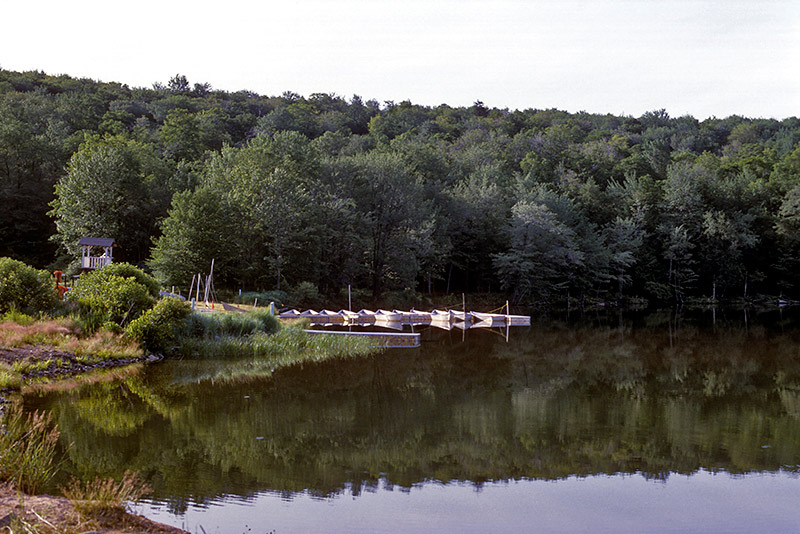
Boating Center (1983)
Almost next to the Boating Center is the Fishing Dock. Onteora was originally the home of a fishing and hunting club and remains a popular spot for would-be anglers.
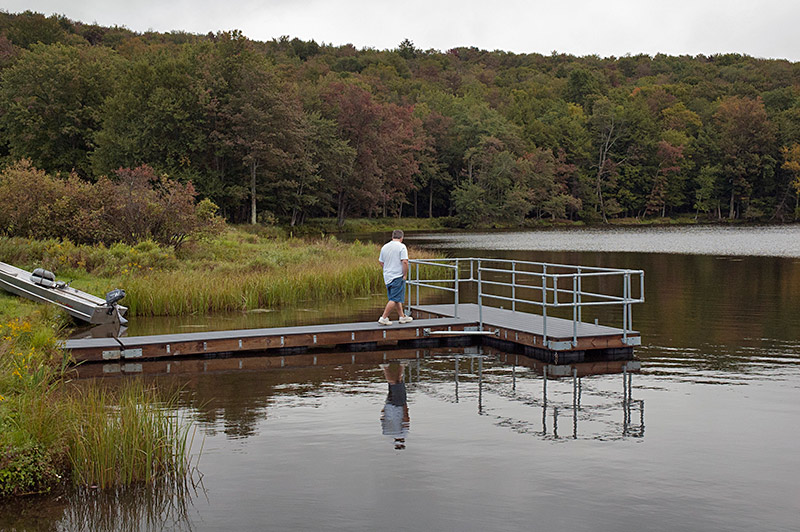
Fishing Dock (2009)
The dock has a small dedication plaque:
To get to the main part of camp you cross a small bridge across Sprague Brook. When I first got to camp in 1963 there was a very rickety and decrepit wooden dock, a legacy from the property's former use as a fish and game club, off on the left side of the brook. I gather that was one of the former trout fishing areas. There's no sign of the dock today, nor of the campsites once in the area, but it's a very quiet and picturesque spot. Next, just after crossing the bridge, you come to a crossroads. You can continue up the hill to the main camping area or spend more time around the lake. We'll visit the campsites later, so let's continue to the left along the shore of Orchard Lake.
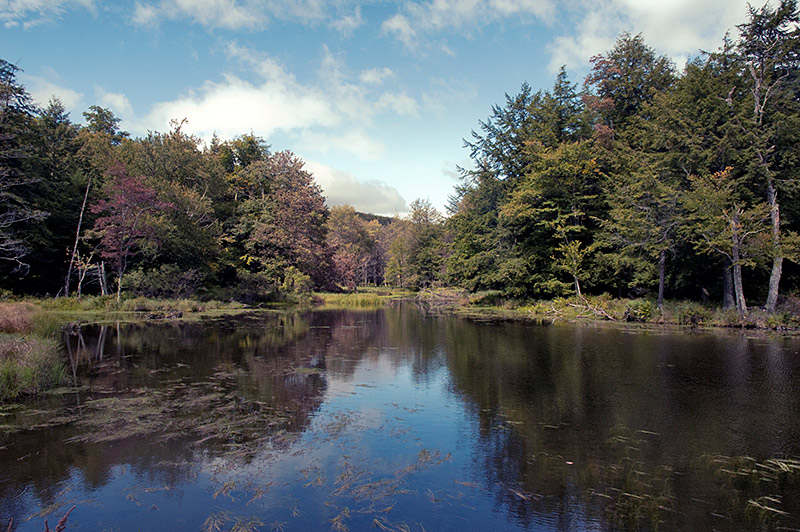
Sprague Brook (2009)
The lake road was once the main entrance to the property, and while it is no longer passable past the dam, it once connected with Onteora Road. The camp road passes by the former sites of the Chiefs and Tribes waterfronts; on the map, the old Chief's site is shown as the "Swim Center", but the Tribes waterfront has vanished. It was located at the end of the trail seen near the Teddy Roosevelt Program Shelter. There was a bridge over the brook when I was on staff and I remember thinking it didn't look like it could hold a car any longer. Some enterprising staffers proved me wrong by using it to sneak out of camp for an unauthorized night off. Today you can barely make out where the bridge once stood.
Also along this road were the Jewish and Protestant Chapels, with the Catholic Chapel located on the road to the Buckskin area. Only one chapel shows on the map; this is the former Jewish Chapel, now used for all faiths, with the Protestant Chapel site now used as the Kenneth M. Heim Memorial Campfire Ring. There were once a few campsites on this road, just as it left the Trading Post area, but they don't show on the map and have long been retired.
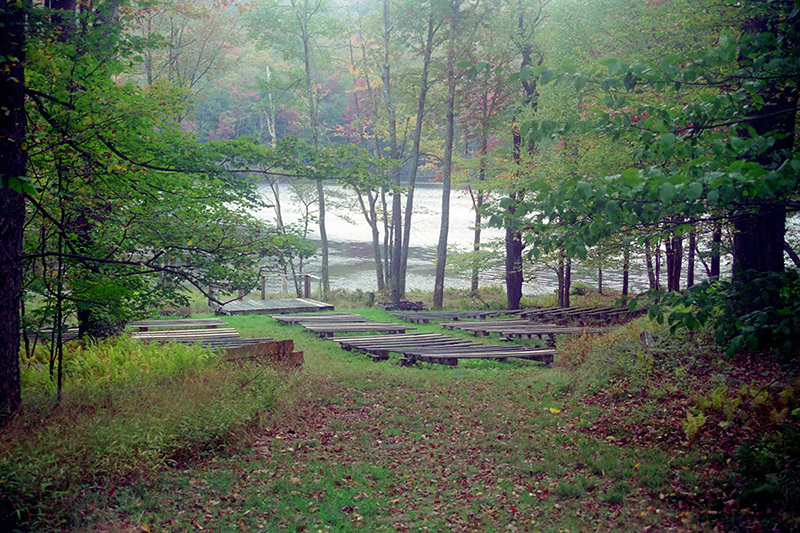
Kenneth M. Heim Memorial Campfire Ring (1998)
The campfire ring has been greatly improved in recent years, and I will include a newer picture on a future update of this site.
During the 1960s and 1970s each of the three camps (Chiefs, Tribes, and Buckskin) had their own waterfronts with a dock, small beach, and boating area. The docks were put together every summer and consisted of deck plates on a scaffold-like frame that extended down to the lake bottom. Hauling these things out of storage and putting them together was one of the worst parts of being a counselor, for they were big, heavy and covered in grease. The lake, which never gets very warm, was still particularly cold during the set-up week. It sure felt good when the docks were finally assembled and you knew you were past that particular hurdle.
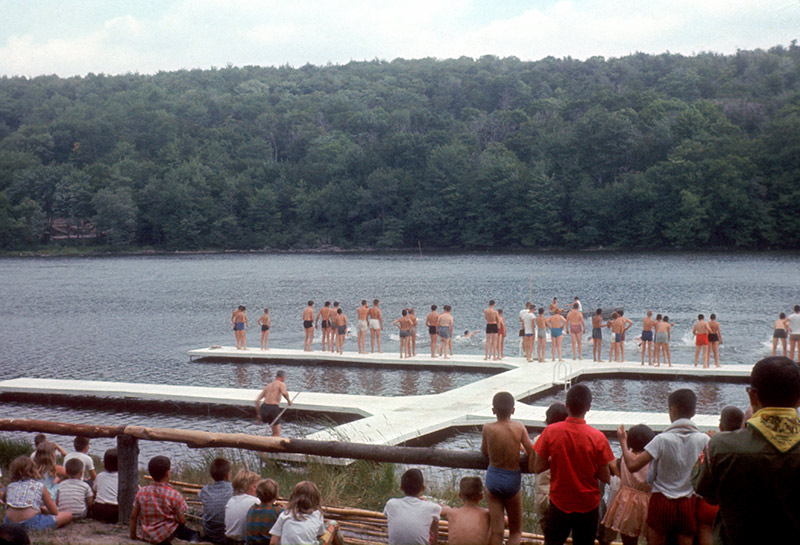
Swim dock on Orchard Lake (1961)
Photo courtesy of Art Robb
Each waterfront uses a buddy system, with all Scouts - including the staff - being tested for swimming abilities and assigned a color rating (red, white and blue.) You are given a tag with your name on it, and you and your buddy hang your tags together on the same hook when entering the lake. There are periodic "buddy checks", where a whistle is used to stop all activities and the buddies need to raise their hands together to show no one was missing. The system seems to work, for I have never heard of any serious incidents on the lake.
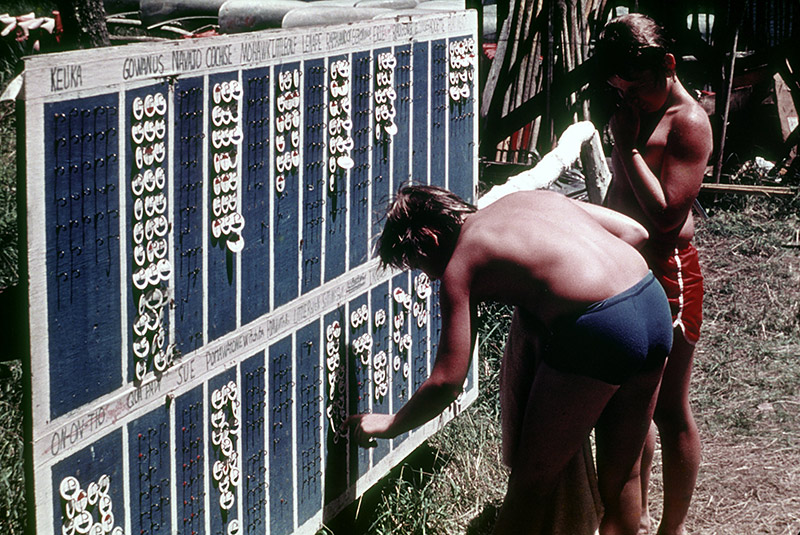
Buddy Tag Board (1970s)
There are canoes, rowboats, sailboats, and kayaks now at camp, which can be used for fishing, racing or just a ride around the lake. The waterfront also features events such a mile-long swim and classes for the various aquatic merit badges. For many of us who didn't have a pool back on Long Island, the waterfronts were one of the best things about camp.
The waterfronts were also a key element of the Parent's Day activities held when the camp operated on a two-week camping cycle. All of the Scouts were encouraged to participate in a variety of activities that included swimming and boating races, diving contests, a beauty contest and more. For some of the Scouts the best part of the day was a chance to dunk the staff into the lake. For some of the staff the best part was meeting the camper's sisters.
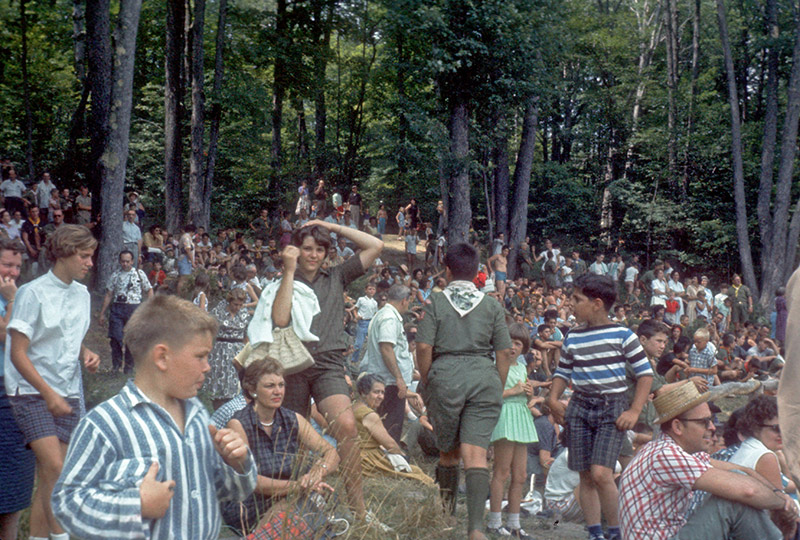
Waterfront audience (1960)
Photo courtesy of Art Robb
Ever wonder how Orchard Lake got its name? Well, at one time, this was an apple orchard! Yes, the lake is man-made, created by the damming of Sprague Brook. When I first arrived at Onteora in 1963, you had to be careful while boating on the eastern side of the lake, for there were plenty of submerged trees ready to snag you. Back when I first put this site together in 1998 some remnants of the orchard could be seen sticking out of the water. I think most of the above water branches are now gone, but a peek into the water will still show the ghostly remains of the old orchard in places.
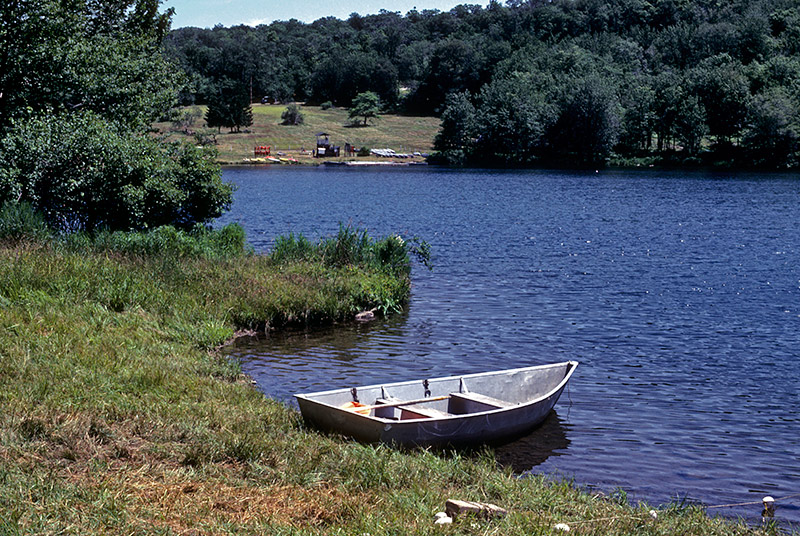
Towards the Boating Center from old Chief's Waterfront area (1983)
After passing the site of the old Tribe's Waterfront you'll soon reach the end of Orchard Lake. At this point you could continue around the lake on what is known as the Red Trail. It crosses the dam across Sprague Brook and follows the shoreline back to the Parade Grounds. This is a very pretty part of the camp, for it offers some great views of the lake and interesting rock formations not far from the shore. During our 1998 visit some beavers were busy chewing through just about every tree at the waterline, adding to the already impressive lodge they had constructed. A beaver lodge is still usually found in this area. Click here for more information on Onteora's extensive trail system, or for now, just continue your tour.
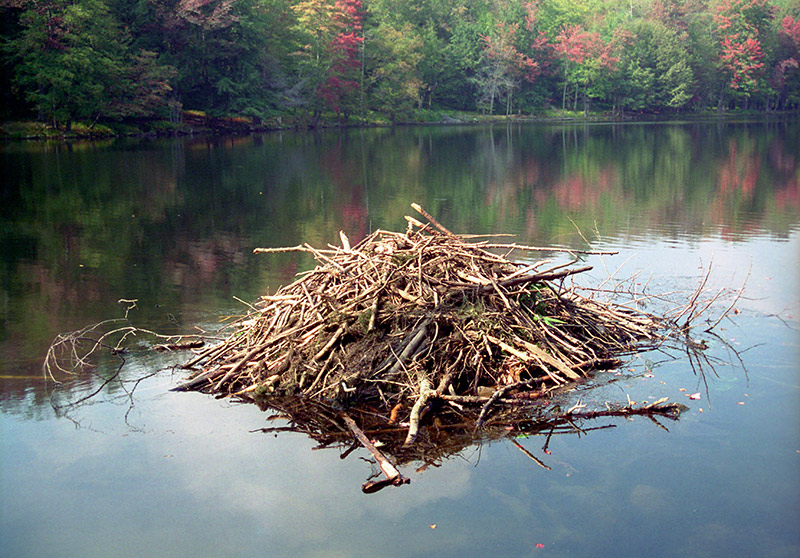
Beaver lodge (1998)
Turning around and heading back to the crossroads brings us to what was once known as the Long Island Trading Post, seen here in 1983. Situated on a slight hill overlooking the lake, the Trading Post was the home of the camp's post office, which did a steady business in letters and postcards to and from home. You could buy scouting supplies, uniforms, knives (a very popular item!) and candy. The motif was very unpolished, with bare wooden counters and metal racks on the walls, but it did a pretty good business anyway. Then again, there wasn't a lot of competition in the neighborhood. The building is still there but is now used as a staff lounge and training center, with the Trading Post itself relocated near the Long House dining hall.
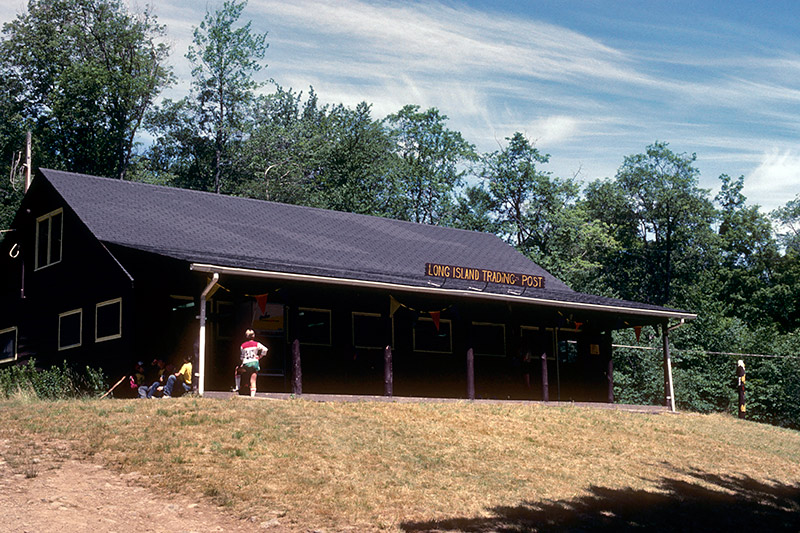
Trading Post (1983)
Ever wonder why it was called the "Long Island Trading Post" and not just "Trading Post"? Bob Oldmixon supplied the answer: "My Dad worked in camp doing all kinds of things for Ken Heim. Making signs with his new router was particularly enjoyable to him. Ken told him we needed a sign for the new Trading Post. He had a long board and thought it would be wasted lumber to just write Trading Post on it so he routed out Long Island Trading Post, since we were all from Long Island."
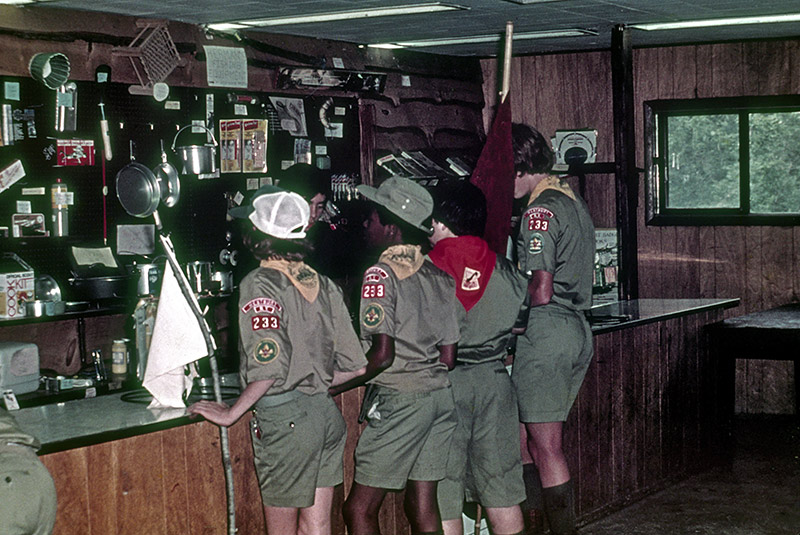
Undated view of the Trading Post interior
Behind the Trading Post is the Power Line Trail, a fairly steep and very rocky climb up to the Water Tower. This tower marks the intersection of the Chiefs and Tribes camp, and thus the trail is a great way to get to the middle of the camp. Great, that is, as long as you are 16 and not carrying a pack. Adult leaders always seem to prefer the long and more level way around. Having the "benefit" of age I can now understand why. What I can't understand is why no one ever got around to doing something about all of those stupid rocks. The trail was closed for several years due to severe erosion problems but has now been restored.
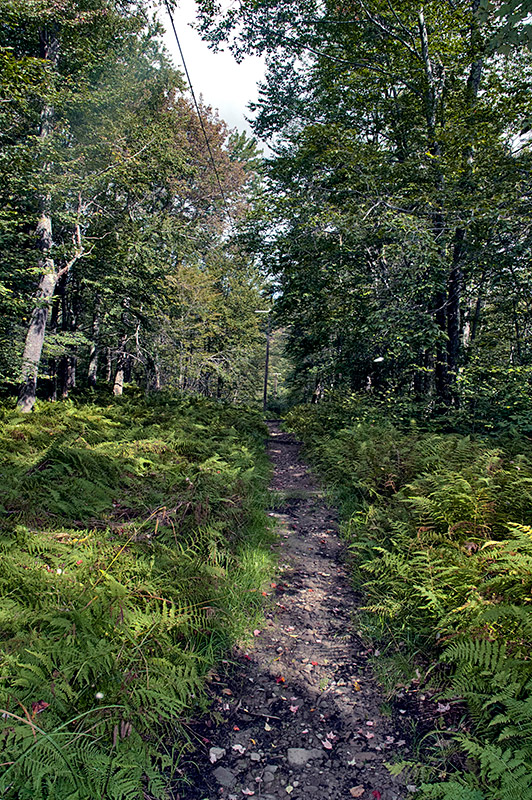
Power Line Trail (2009)
That's pretty much it for the lake area. Continue your tour with the menu below.